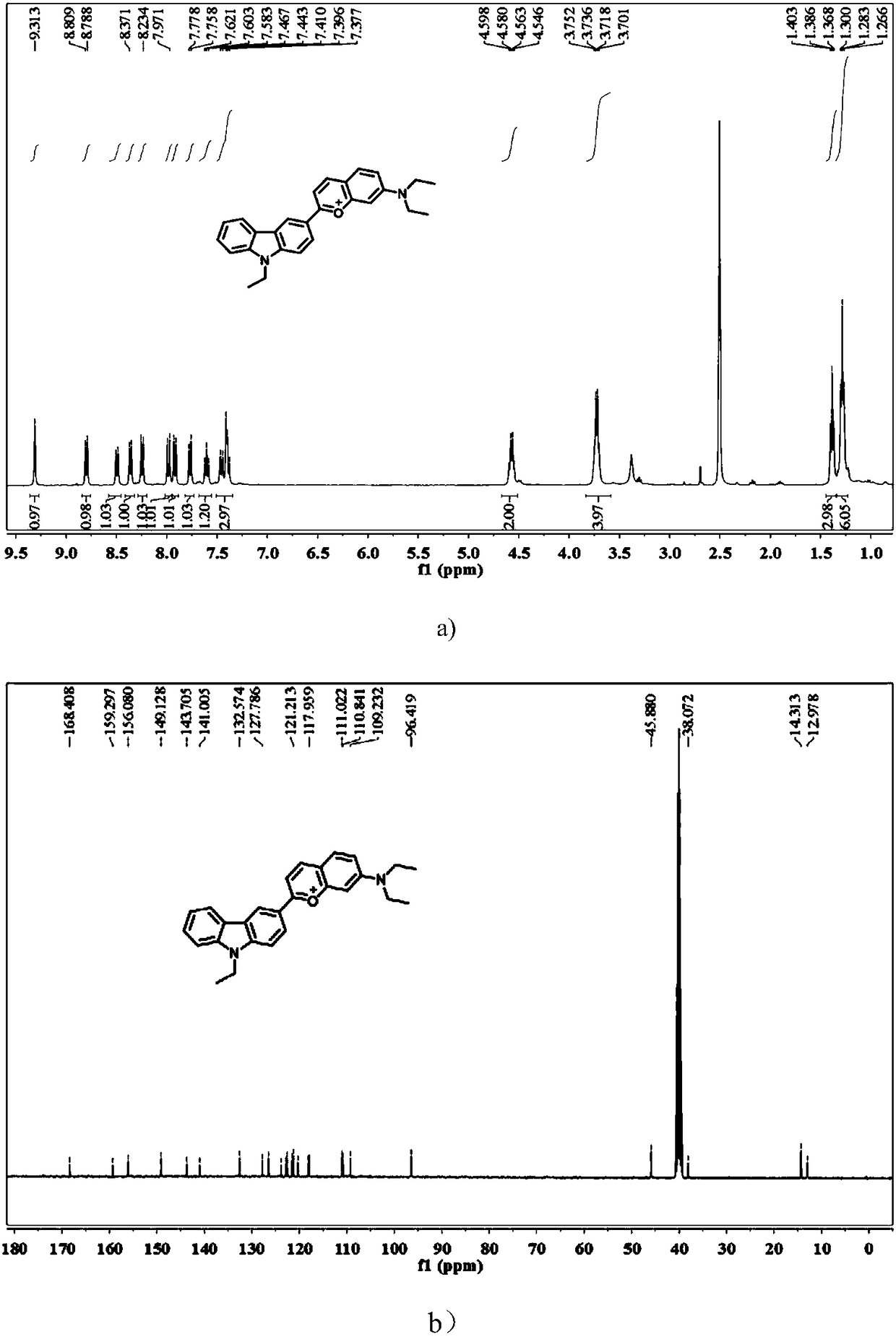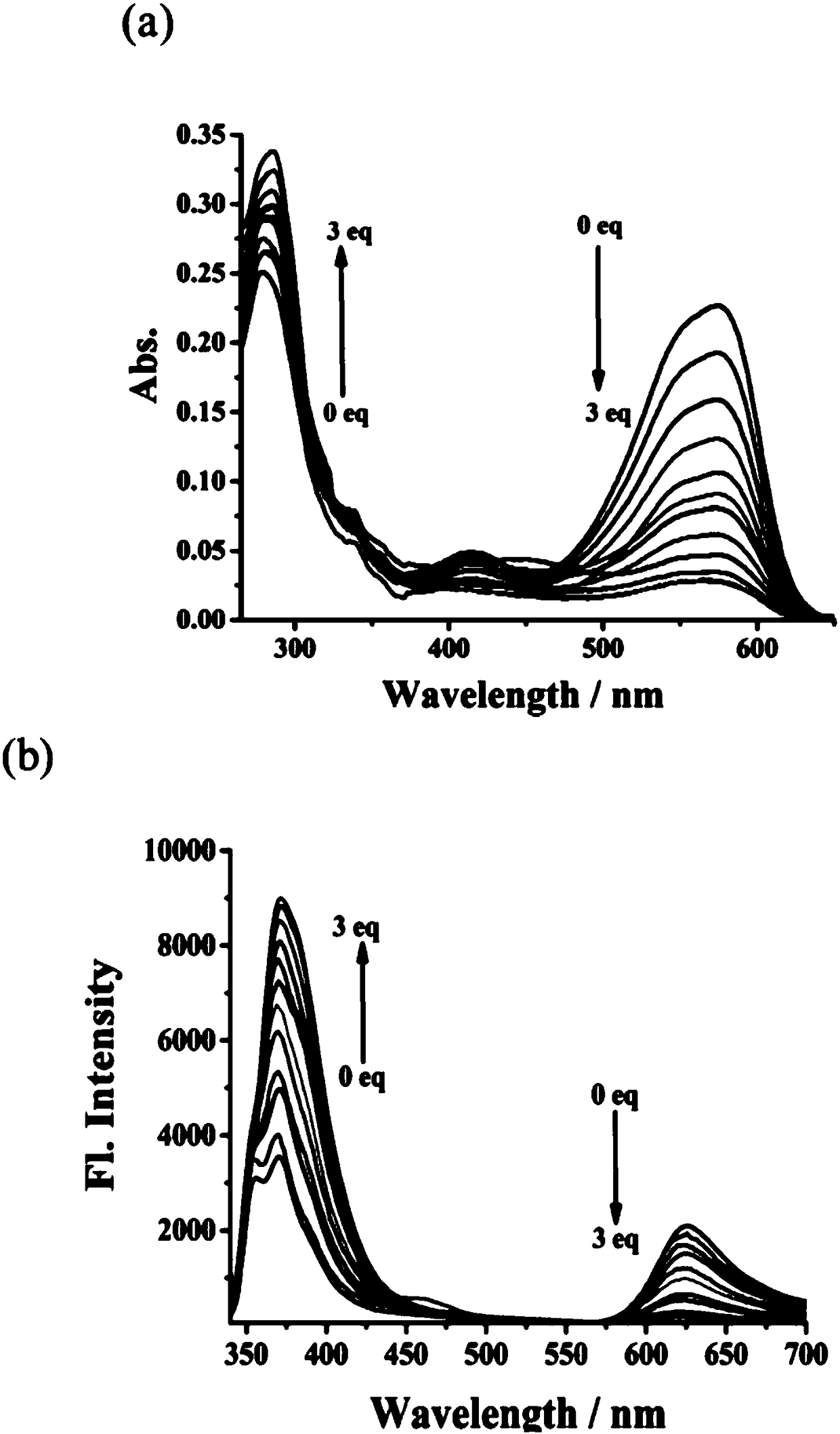Fluorescent probe of reversible sulfur dioxide/sulphurous acid (hydrogen) salt
A technology of sulfur dioxide and fluorescent probes, applied in the fields of fluorescence/phosphorescence, luminescent materials, organic chemistry, etc., can solve the problems of lack of detection, etc., and achieve the effect of easy-to-obtain raw materials, simple synthesis steps, and high yield
- Summary
- Abstract
- Description
- Claims
- Application Information
AI Technical Summary
Problems solved by technology
Method used
Image
Examples
Embodiment 1
[0041] Example 1 Preparation of Fluorescent Probes for Reversible Sulfur Dioxide / Sulfite (Hydrogen) Salt
[0042] (1) Synthesis of compound 9-ethyl-9H-carbazole (4):
[0043] ;
[0044] At room temperature, add 1.67 g carbazole (1) (10 mmol) and 240 mg sodium hydride (3) (6 mmol) into a flask filled with 6 mL DMF, stir for 1.5 hours, then add 5.4 g bromoethane dropwise (50 mmol) (2), stirred at room temperature for 2 hours, poured the reaction system into 150 mL of ice water, extracted with ethyl acetate, dried the ethyl acetate layer with anhydrous sodium sulfate, and removed the ethyl acetate under reduced pressure to obtain white The needle-like compound 9-ethyl-9H-carbazole (4), yield 87%. The product was directly carried out to the next reaction without further purification.
[0045] (2) Synthesis of compound 3-acetyl-9-ethyl-9H-carbazole (6):
[0046] ;
[0047] Weigh 975 mg of 9-ethyl-9H-carbazole (4) (5 mmol) into the reaction flask, add 4 mL of DCM, add 1.33 ...
Embodiment 2
[0051] Example 2 Different concentrations of SO 2 Absorption Spectrum Test and Fluorescence Test of
[0052] A dimethyl sulfoxide (DMSO) stock solution of the fluorescent probe CaP in Example 1 with a concentration of 1 mM was prepared for use.
[0053] Take an appropriate amount of fluorescent probe CaP for detecting sulfur dioxide according to the present invention in a 5 mL volumetric flask, and add an appropriate amount of acetonitrile to make the mother liquor concentration 1 mM; weigh a certain amount of sodium bisulfite and formaldehyde and dissolve them in ultrapure in water to make the stock solution concentration 100 mM. In the test solution, the concentration of the probe is 10 μM, and the concentration of sodium bisulfite is 0 μM, 1 μM, 2 μM, 5 μM, 8 μM, 10 μM, 12 μM, 15 μM, 18 μM, 20 μM, 25 μM , 30 μM, use HEPES buffer (HEPES, 10 mM, pH=7.4) to make up to volume, which contains acetonitrile with a volume fraction of 20%. Then carry out absorption spectrum test ...
Embodiment 3
[0054] Example 3 Detection of reversible performance of fluorescent probe CaP
[0055] Prepare 100 mM sodium bisulfite solution and 100 mM formaldehyde solution for later use.
[0056] Add 20 μL of the probe mother solution (1 mM) in Example 2 and 380 μL of acetonitrile into a 5 mL volumetric flask, make up to volume with HEPES buffer, shake well and perform fluorescence detection (λex = 270 nm, λem = 370 nm, 630 nm), to establish a curve of fluorescence intensity versus time; then add sodium bisulfite solution (final concentration: 30 µM) to the above system, shake well and perform fluorescence detection (λex = 270 nm, λem = 370 nm, 630 nm) to establish a curve of fluorescence intensity versus time; after the above solution was equilibrated, add formaldehyde solution (final concentration 300 µM) to establish a curve of fluorescence intensity versus time, the results are as follows image 3 shown. Depend on image 3 It can be found that in the presence of sulfite, the near-...
PUM
 Login to View More
Login to View More Abstract
Description
Claims
Application Information
 Login to View More
Login to View More - R&D
- Intellectual Property
- Life Sciences
- Materials
- Tech Scout
- Unparalleled Data Quality
- Higher Quality Content
- 60% Fewer Hallucinations
Browse by: Latest US Patents, China's latest patents, Technical Efficacy Thesaurus, Application Domain, Technology Topic, Popular Technical Reports.
© 2025 PatSnap. All rights reserved.Legal|Privacy policy|Modern Slavery Act Transparency Statement|Sitemap|About US| Contact US: help@patsnap.com



